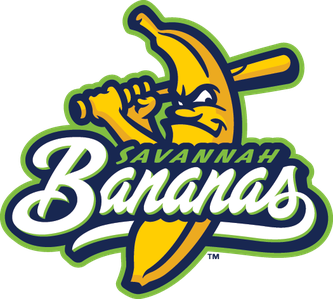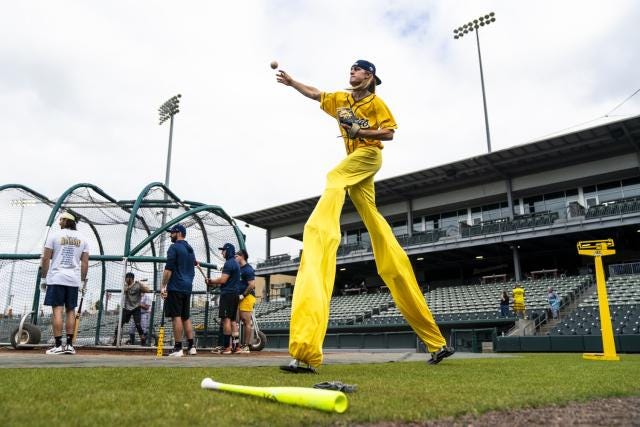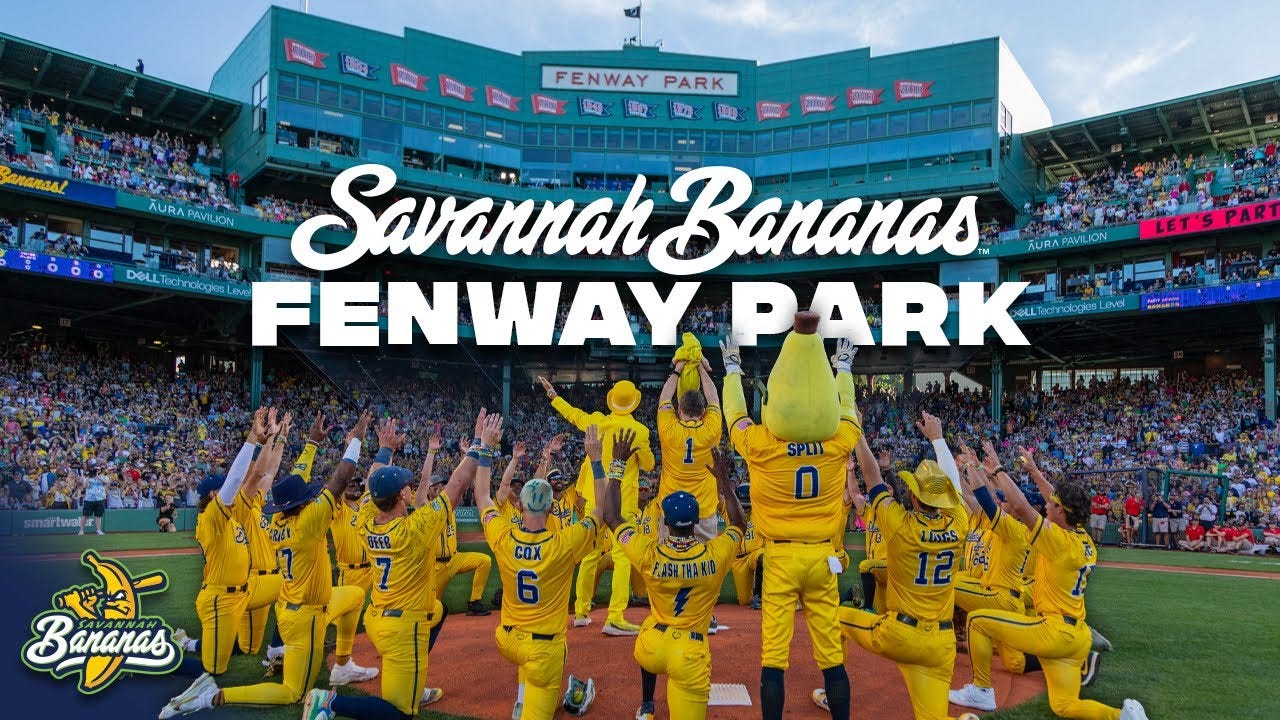You’ve probably heard of the Savannah Bananas by now.
They’re the Harlem Globetrotters of baseball. Founded in 2016, the Bananas are an exhibition team that crisscrosses the country, treating the game less like a traditional sport and more like a high-energy spectacle.
It’s entertainment for our fragmented, inattentive era: a relentless stream of dances, backflips, stadium-wide singalongs, and—oh yeah—baseball, or at least something like it.
They call it Banana Ball, an alternate and very yellow sports universe where the rules reward showmanship and the games unfold in a flurry of ten second bursts.
Look, the pitcher’s on stilts!
The umpire is twerking!
The outfielder just caught a line drive behind his back—with his bare hand!!!
Dakota “Stilts” Albritton, the “tallest man in sports”
In Bananaland, not FEAR, but BOREDOM “is the enemy, the mind-killer, the little death that brings total obliteration.”
You will never be bored here. The Bananas have banished boredom.
In short, it’s baseball on Adderall and Mountain Dew for minds conditioned by iPhones.
It also happens to be uplifting, funny, and arguably the most refreshing development in the sport in years.
What should we make of this craze that just sold out Fenway Park—not once, but twice—and appears poised to shape the future of baseball?
Here’s our fork in the road: embrace a faster, more entertaining version of baseball, or stick with the slower pace of pitchers’ duels, extra innings, and extended at-bats that allow tension to simmer across a long afternoon?
Professional sports leagues everywhere are confronting this dilemma. How to capture and retain the focus of Gen Z and Gen Alpha, generations shaped by the instant gratification of YouTube and TikTok?
Our quest, then, is to explore the future of baseball—and how it can evolve to thrive in this new era. Let’s dive in and unpack it together.
The Bananas at Fenway
This past weekend, I attended the second of the Savannah Bananas’ 2025 Fenway games, part of their Banana Ball World Tour that brought the exhibition team back to Boston for a sold-out series against the opposing “Firefighters.”
It was a muggy afternoon in Boston, and our group of family and friends arrived at the ballpark an hour before the first pitch.
I’ve been to dozens of Red Sox games over the years, and I’ve never seen Fenway so packed so early, with lines snaking through the gates and a buzz in the air well before game time.
We waded through a sea of yellow jerseys in the concourse: men, children, and many, many women decked out in Bananas gear. Banana Ball is distinctly southern—many of the players are former college ball players from the Southeast—and more than a little sexualized.
Shirtless, southern musclemen: the aesthetic leans into a playful, performative masculinity that’s tantalizing to some while still family friendly enough. The carnal undercurrents of Banana-dom is a fascinating topic for another essay. Sometimes a cigar is just a cigar, as Freud purportedly said, and maybe a banana is just a banana. But there’s definitely a “there there,” a layer of camp and charisma and kitsch that adds to the spectacle.
For now, suffice it to say, the Bananas players are eye candy for the ladies—Chippendales in cleats, flexing and flipping their way through the show.
As we watched the player intros, my twenty-two-year-old sister and her friends played “Hug or Pass” as the players appeared on the Jumbotron. Many “hugs” were given, with giggles and commentary filling our section.
Meanwhile, the pregame at a Bananas exhibition is no normal pregame; it’s a full-blown carnival designed to hook the crowd from the start.
There were races around the basepaths, dancing contests, and a particularly entertaining game in which a blindfolded middle-aged man with a dad bod crawled on the ground to find a banana as the crowd booed when he crawled farther away (cold!) and cheered as he approached (hot!) and finally grasped it (on fire!). We wondered if he would eat the banana—(he did not).
It turns out there are no dull moments—none—at a Bananas game. The show is designed to hold our attention, grabbing the viewer by the collar and not allowing them to look away, like catnip for wandering minds.
When it was time for the first pitch (and the time seemed to fly), it was none other than New England legend Doug Flutie who threw out the first pitch to the opposing “Firefighters.”
He tossed a ball in the dirt a few feet short of the catcher. Unsatisfied, he stayed on the mound, the umpire did a twerk or two to keep the energy up, and allowed Flutie to simply pitch the entirety of the first at-bat. Eight pitches later, the batter hit a pop-up to third base.
This set the tone for the rest of the afternoon, in which the rules were bent—or outright rewritten—to serve the holiest of commandments: ENTERTAIN.
Gen Z and Gen Alpha—today’s twenty-somethings, teens, and children—are simply not engaging with sports as previous generations did. They don’t attend live games as much, and they prefer to watch clips on social media rather than full games on TV, a shift that reflects broader changes in attention spans and media consumption.
Major League Baseball understands this represents an existential crisis. They’ve taken successful measures to shorten the games, like introducing pitch clocks and rules to accelerate extra innings. But they don’t do it like the Bananas do, turning every inning into a viral moment.
The rules of Banana Ball are a lot to digest, so for the first few innings our group had a cheat sheet pulled up on our phones, like newcomers to a foreign sport.
There are no walks, but around-the-bases sprints on ball four, turning potential lulls into bursts of action.
The game is capped at two hours, and the game clock is always shown prominently: there is a clearly defined end to this spectacle, which keeps the pace brisk and the audience engaged.
Trick plays are rewarded, and every inning has a winner of a point: whoever scores the most runs gets a point. This prevents runaways, even if the Bananas usually (but not always) win. It’s not rigged like pro wrestling, but the thumb is on the scale, with outcomes tilted toward maximum fun. Again, total entertainment is the guiding commandment.
Best of all is the foul ball rule: if a fan catches a foul ball, the batter is out. This is ingenious; it turns passive spectators into active participants. More kids than not had gloves, and they were glued to the game, eyes darting skyward with every crack of the bat.
As the game proceeded—with goofy antics aplenty, from backflips in the outfield to the crowd-favorite dancing umpire—I was struck by the music. It’s a constant barrage of TikTok songs that plays out exactly like clips on the TikTok platform: switching every ten seconds, a soundtrack engineered for short attention spans.
The music played as the players played, with familiar favorites and kid-friendly meme-songs underscoring every pitch and swing.
The announcer bellowed: KNOCK KNOCK!
WHO’S THEREEEE? the crowd responded.
THEY SEE.
THEY SEE WHO?
DEYYY SEE ME ROLLIN, DEY HATINNN, PATROLLINNN, TRYIN TO CATCH ME RIDIN DIRTYYYY
Everyone laughed as the batter hit a soft grounder to the first baseman, who didn’t merely step but pirouetted across first base. A routine play to remember.
The two announcers, one in a yellow suit and the other in a sparkly silver jacket, narrated the action and kept things flowing, their banter as much a part of the show as the game itself.
In the middle innings, they brought a parade of former Red Sox greats (dressed head to toe in Bananas garb) to throw out pitches and take at-bats: Bill Lee, the 78-year-old “Spaceman,” who induced a fly out and celebrated by stripping off his shirt to roaring approval; Jackie Bradley Jr., who got hit by a pitch before later flying out; and Johnny Damon, who lined out sharply. These were genuinely poignant moments, bridging Boston’s baseball history with the Bananas’ irreverent present.
At one point, the only female player on the Firefighters took an at-bat, and the women in the crowd screamed as she belted a line drive to the center fielder, who caught it sheepishly amid boos and applause.
After the seventh inning, they paid tribute to not just the troops, police officers, and first responders but also to teachers and a few other professions I couldn’t quite make out over the deafening applause. Among many other things, the Bananas are feel-good Americana; their organization Bananas Foster (again, ingenious) highlights foster families and, through a partnership with Comfort Cases, has delivered more than 265,000 backpacks to foster children.
After the eighth inning, the crowd did a boisterous singalong to “Yellow” by Coldplay. 36,000 people belting out “It was all yellow.” I don’t love Coldplay, but I appreciated the moment.
Soon after, the game ended, the Bananas gathered at home plate for a raucous send-off, and the crowd filtered out of Fenway, perhaps unchanged but undoubtedly entertained.
The cumulative experience was dizzying: an assault on the senses, from the stunts to the costumes to the music to the chants.
And then there’s the baseball. It’s still there—sort of—but it shares the stage now with TikTok dances and shirtless showmanship and crowd chants that feel pulled from a minor league fever dream.
I watched the regular old Red Sox on TV the next day and couldn’t help but think of how dull it seemed in comparison, a reminder that while tradition has its place, the future of sports may lie in this kind of unapologetic entertainment.
Traditional baseball seemed like it was playing at half-speed, as if everyone on the field—and in the stands—had taken a Xanax. What’s next for this famously slow sport?
The Future of Baseball
Back to our quest: exploring that fork in the road between embracing a faster, flashier game or clinging to the slow-burn rituals that have defined America’s pastime for over a century.
The Savannah Bananas might’ve cracked the code on captivating Gens Z and Alpha—sold-out stadiums, viral clips racking up millions of views, and a fanbase that skews young, female, and diverse. It’s proof that baseball can thrive if it sheds some of its solemnity and injects a dose of chaos. But it’s here that I’m conflicted.
On one hand, Banana Ball feels like a lifeline. MLB attendance has been dipping, with younger fans opting for esports or 30-second highlights over nine innings of pitchers staring down batters. The Bananas’ innovations—two-hour caps, point-per-inning scoring, fan-caught fouls—keep things moving, turning potential snoozefests into adrenaline rushes.
Yet part of me recoils at the frenzy. If sports become too enamored with fast entertainment, I worry that we might all go bananas in the worst way—overstimulated, exhausted, craving the quiet poetry of a lazy double play.
This broader condensing of media is happening everywhere—not just in baseball. Shorter play times on the field, shorter songs that hook you in the first 10 seconds on TikTok playlists, shorter everything, from podcasts to movies. It's the Great Shortening, a cultural pivot to combat our collective attention deficit, ensuring nothing drags on long enough to lose us.
I dove deeper into this phenomenon in Quest 13, "Shorten Everythi—," where I wrote about the peril and the promise of cultural compression. Banana Ball fits right in, distilling the essence of baseball into bite-sized bursts that keep the dopamine flowing.
Is this progress, or a sugar rush that leaves us crashing?
I honestly don’t know: I’m still stuck in this push-pull. Frankly, the Bananas aren’t replacing the MLB any time soon; they’re a side show, a laboratory for ideas.
But what if they point to a hybrid future?
Here’s a suggestion: MLB should pilot “Banana Nights” in select (and, at first, inconsequential) games—incorporate elements like fan outs on fouls or mid-inning challenges, but only during the preseason or All-Star games, to spice things up without gutting the core. The league could also test it in the minor leagues first, gather data on engagement, and scale from there. It could infuse energy while honoring the game’s roots.
TikTokifying may be a necessary evil—well, not evil, but something—to prolong baseball’s life span.
Ultimately, I’m torn: thrilled by the Bananas’ vibrancy but wary of losing baseball’s soul. Change is inevitable, but let’s not throw out the baby with the bathwater—or the banana peel.
With that…
Here’s Quest 26:
Go Bananas
Key Details:
Grab tickets to a Savannah Bananas game: their world tour is expanding—check out thesavannahbananas.com. Experience the madness yourself and decide where you land on the spectrum.
If you’re already a diehard Bananas fan, consider writing to your local MLB team or the commissioner’s office with your thoughts on blending tradition and entertainment. Suggest those Banana Nights pilots—fan feedback could spark real reform.
Let’s keep the conversation going. What’s your take on baseball’s future? Leave a comment below.
And, as always, thanks for reading!







